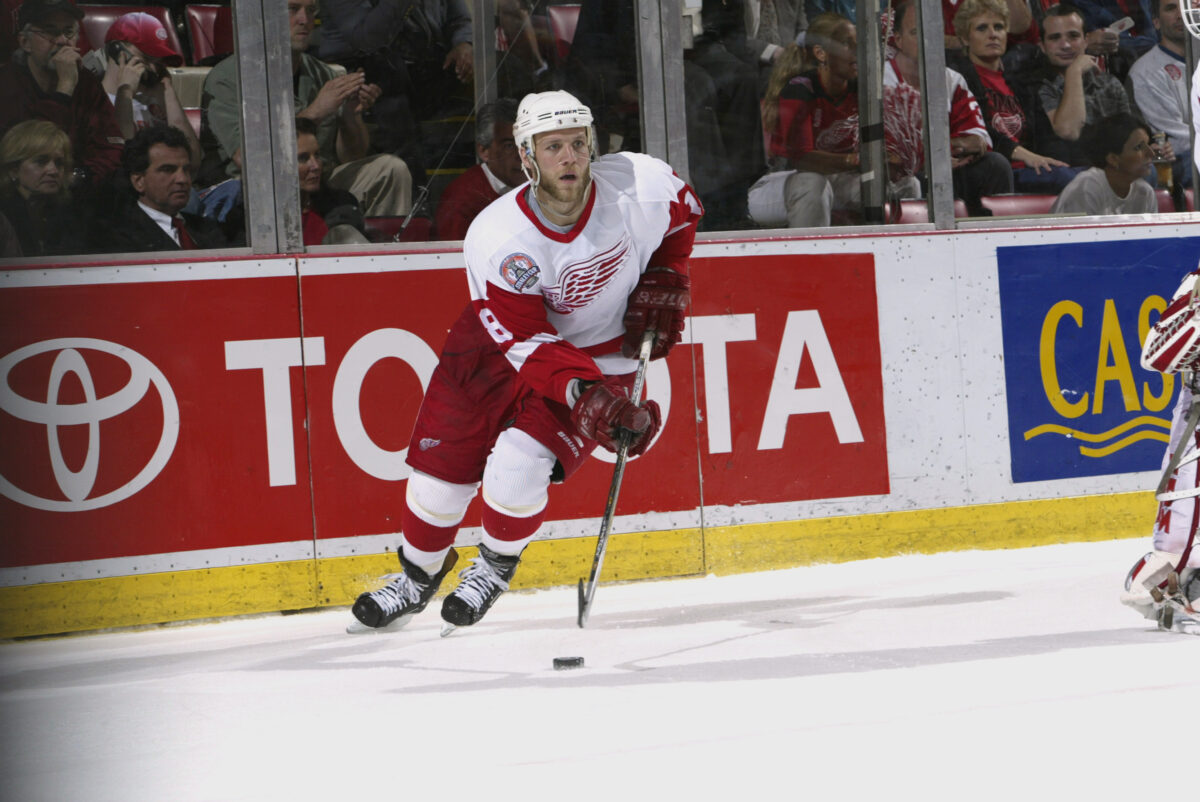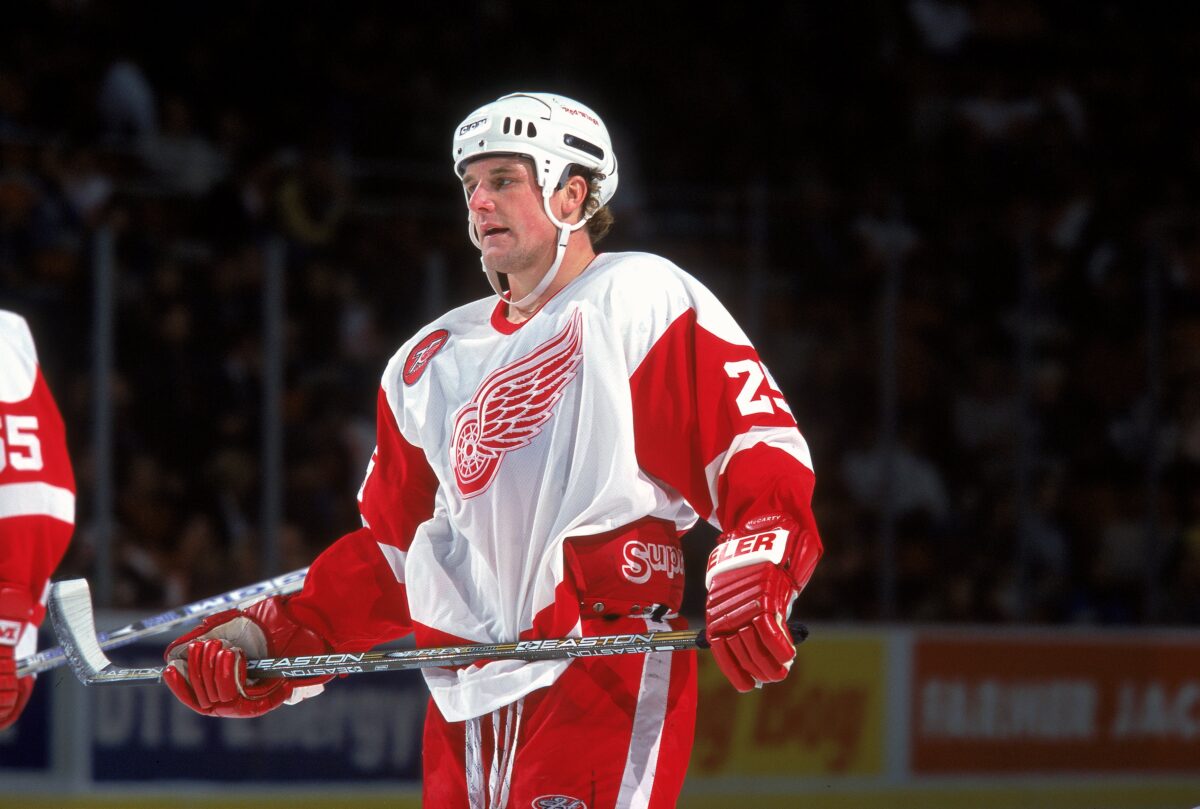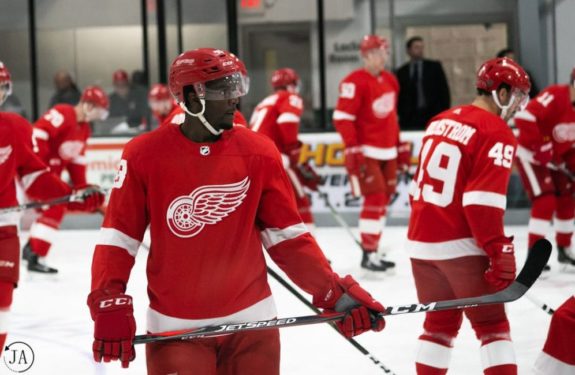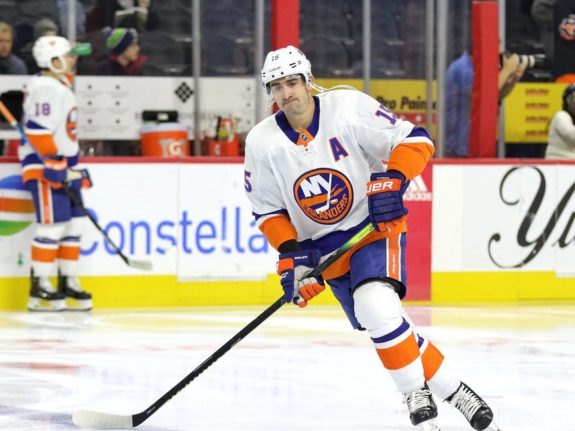What’s The Grind Line? Apart from the once-famous line of Kris Draper, Kirk Maltby, and either Joe Kocur or Darren McCarty, The Grind Line is also The Hockey Writers’ weekly column about the Detroit Red Wings. This week Tony Wolak, Devin Little, Patrick Brown, and Kyle Knopp are the muckers who make up THW’s forechecking unit and sound off on Red Wings topics.
Our weekly column will strike a slightly different tune this time around because we had the privilege of hosting McCarty on the most recent episode of our weekly podcast. You can find it on The Hockey Writers’ YouTube channel, or even just scroll to the bottom of this column to catch it. Still, the whole experience got us thinking: What are some of the best memories (or favorite highlights) of our namesake, what impact did its presence have in the sport, and what current Red Wings could be honorary Grind Liners?
Let’s sound off.
What’s The Best Grind Line Highlight (Or Memory)?
Tony Wolak: Probably Kris Draper’s overtime goal in Game 2 of the 1998 Stanley Cup Final. I know you can hear Gary Thorne calling the goal right now.
Devin Little: Maybe I’m showing my “youth” here, but I’m going to say 2008 when the Grind Line was reunited. Kirk Maltby and Draper had remained with the team throughout the years, but Darren McCarty spent some time away from the organization. In the 2007-08 season, McCarty returned, and the Red Wings, this time under head coach Mike Babcock, would clinch the franchise’s 11th Stanley Cup title.
Kyle Knopp: Despite all the great memories the Grind Line provided over the years, the highlight(s) I feel most exemplify its contributions are the two goals by Maltby and Kocur in the first period of Game 1 against the Philadelphia Flyers in the 1997 Stanley Cup Final. Draper and Maltby worked together to open the scoring with a shorthanded goal, while Kocur stole a pass and showed the skill that the line possessed as well. To top it off, McCarty assisted on Sergei Fedorov’s game-winning goal in that game, giving all four Grind Line members a point in the first game of the series that ended the Wings drought.

Pat Brown: Yep, I’ll take the low-hanging fruit here. March 26, 1997. Yes, Igor Larionov inadvertently started the melee, and Brendan Shanahan‘s flying leap (followed by Mike Vernon’s subsequent fight and takedown of Patrick Roy) give us warm fuzzies, but McCarty’s pummeling of Claude Lemieux — not to mention his game-winning overtime goal — set the trajectory of the Red Wings dynasty for years to come.
What Was The Grind Line’s Impact on Hockey?
Tony Wolak: The Grind Line showed the hockey world that a fourth line could serve in a shutdown role and could hold their own against opponents’ top six. They revolutionized NHL rosters and deployment strategies.
Devin Little: You don’t have to look too far before you find some Wings fan lamenting the lack of grit on the roster. I think those stem from watching the Grind Line do their thing for years; you don’t necessarily realize how important grit is until you’ve had it, and then you suddenly don’t. Also, they impacted hockey by being the namesake for not one but TWO podcasts!
Kyle Knopp: Although they weren’t the first, the Grind Line solidified the use of a bottom-six line that was tough as nails but could score at will. All four members of the Grind Line were talented goal scorers, but it was their grit and tenacity that separated them as a special unit. They could get it done on both sides of the puck while being able to provide a much-needed spark against an opposing team.

Pat Brown: I think the line really demonstrated the balance that could be struck between beautiful, puck possession hockey and checking-line caliber play. In fact, the aforementioned Grind Line contributions in the 1997 Stanley Cup Final cannot be overstated — McCarty’s championship-clinching goal in 1997 highlighted the beauty that its “tough guys” could contribute.
What Current Red Wing(s) Could Be Part of a Grind Line Reboot?
Tony Wolak: I saw Luke Glendening, Adam Erne, and Darren Helm as a contemporary version of The Grind Line this season. Think about it. They were tough to play against defensively, scored a fair amount, and played with speed and tenacity. Not a Draper-Maltby-McCarty/Kocur combo, but effective nonetheless.
Devin Little: I think Glendening, Erne, and Givani Smith is your “Grind Line” of the 2021-22 season, for what it’s worth. Smith, in particular, seems tailor-made for a modern-day Grind Line.

Kyle Knopp: Unfortunately, the Wings are still lacking the grit of a true Grind Line, or else Jamie Benn would never have gotten away with the cross-check on Dylan Larkin. The closest thing they had this season was Helm to match Draper’s speed up the middle, with Erne and Smith matching the physicality on the wings. I think Smith is the closest player the Wings currently have to an original Grind Line member.
Pat Brown: Smith would be the best fit, in my opinion, and I think he’d do the namesake proud with a combination of grit and skill. Much like my counterparts, I think Glendening and Erne fit the bill, though in my own mind (and in his better days), I had always likened Helm as being a player comparable to Draper.
Can A Similar Line Still Be Effective in Today’s Game?
Tony Wolak: I mean, the New York Islanders seem to be doing just fine with Casey Cizikas, Matt Martin, and Cal Clutterbuck stifling opponents as Barry Trotz’s fourth line.
Devin Little: I think Tony hit the nail on the head here. To further the point, many coaches seem to call them “energy lines” now, and that’s for a good reason. A good shift from a line like this not only gives your team energy but it also sends a jolt of electricity through the crowd as well. Goals aren’t the only way to get the crowd engaged!

Kyle Knopp: The Grind Line changed how the third and fourth lines were perceived moving into the 2000s. No longer was one line a dedicated checking or fighting line; instead, your checking lines could also provide timely goals when needed. As the game evolved to move away from the clutching and grabbing after the two lockouts in the 2004-05 and 2012-13 seasons, more teams started relying on skilled players to play a more grinding role. It’s now almost impossible to win a Cup without some type of Grind Line at your disposal.
Latest Red Wings Content:
Pat Brown: Yes, hands down. Sure, the game has sped up considerably, but when you look at young players coming in who still have that physical element as part of their game, it’s clear there will always be the need to have an enforcer or two. Someone to stand up for your star players (as Kyle mentioned re: the Larkin hit) and help with some much-needed energy when the team (and crowd) needs it most.
What are some of your favorite Grind Line memories? Share your thoughts in the comment section below.
Want more Red Wings content? Tune into The Hockey Writers’ Grind Line — a weekly show on YouTube and Facebook. Check out our most recent show below complete with an appearance from Darren McCarty, and make sure you subscribe to the channel so you don’t miss any upcoming shows.
A die-hard hockey fan in the desert, and proud Iowa State alum. Covers the Detroit Red Wings for The Hockey Writers.

